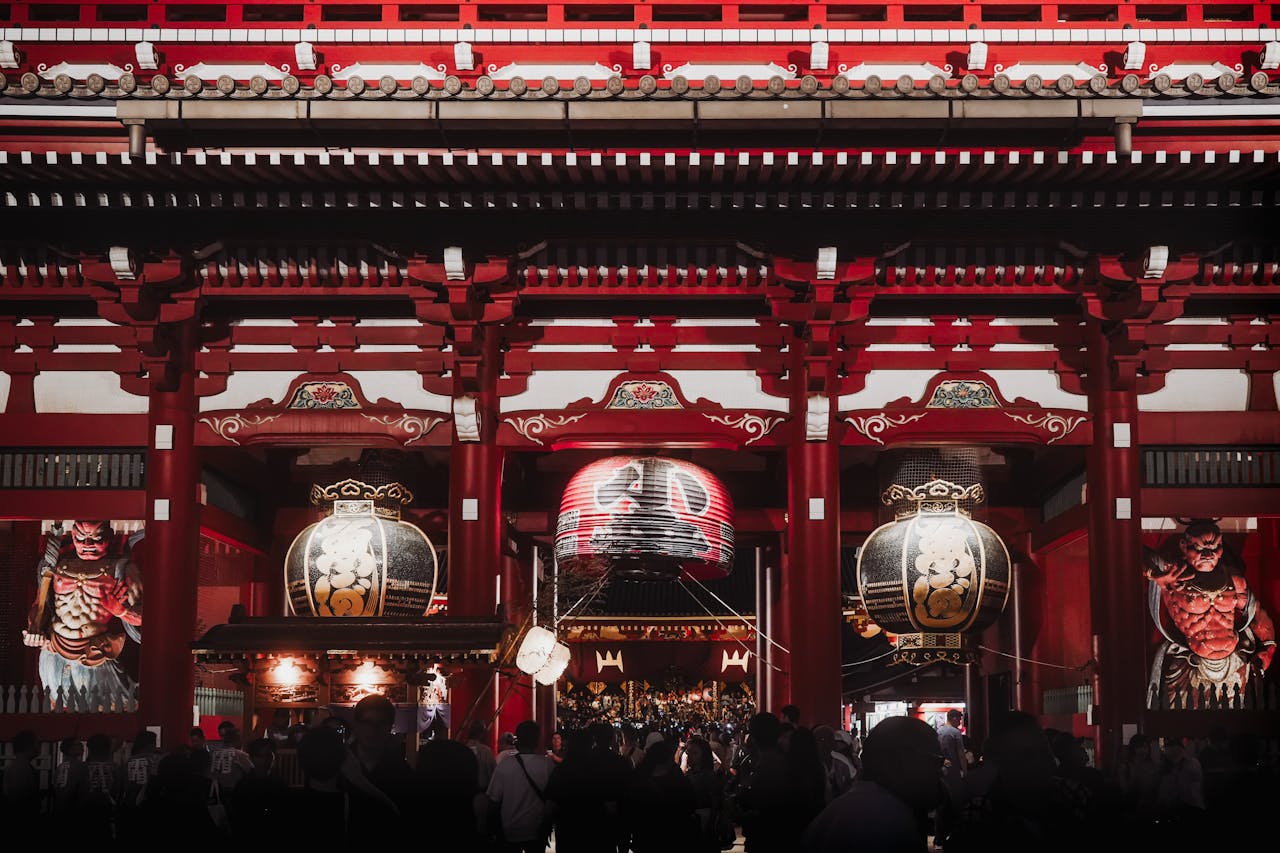Asakusa is one of Tokyo’s most historically enchanting districts, preserving the atmosphere of old Tokyo. With its famous Sensoji Temple, bustling Nakamise Shopping Street, and unique traditional cultural ambiance, it attracts countless visitors eager to explore.
Key Points for Visiting Asakusa
- Sensoji Temple is one of Tokyo’s oldest and most famous Buddhist temples
- Nakamise Shopping Street has over 250 years of history, making it Japan’s oldest commercial street
- Experience rickshaw rides or take a water bus tour on the Sumida River
- Cherry blossoms in spring and the Sumida River Fireworks Festival in summer
- A concentration of traditional snacks and craft shops
Historical Background of Asakusa
During the Edo period (1603-1867), Asakusa was an important entertainment district in Tokyo, featuring kabuki theaters and a red-light district. In the Meiji era, modern entertainment facilities like cinemas also established themselves here. Although the air raids of 1945 destroyed much of Asakusa, the area centered around Sensoji Temple has been rebuilt and regained its former popularity. The opening of Tokyo Skytree has further boosted Asakusa’s tourism.
Main Attractions in Asakusa
Sensoji Temple
Founded in 628, Sensoji is Tokyo’s oldest and most famous Buddhist temple. Although the current buildings are post-war reconstructions, they retain their original solemn grandeur. The worship route includes:
- Kaminarimon Gate: The first main gate to enter Sensoji and Asakusa’s iconic structure. The huge red lantern with “Kaminarimon” written on it is a must-photograph spot for tourists.
- Hozomon Gate: The second gate, also known as “Niomon,” guarded by two imposing Nio statues.
- Main Hall: Dedicated to Kannon Bodhisattva, it’s always bustling with worshippers. Visitors can draw fortunes or purchase amulets here.
- Five-storied Pagoda: Standing 53 meters tall, it’s one of Asakusa’s landmarks, especially beautiful when lit up at night.
Sensoji hosts various traditional festivals and events throughout the year, such as the Sanja Matsuri held every May, one of Tokyo’s three major festivals.
Nakamise Shopping Street
This 250-meter long shopping street connects Kaminarimon Gate to Sensoji Temple, featuring over 90 shops selling various traditional snacks and souvenirs. It preserves the atmosphere of the Edo period and is an excellent place to experience old Tokyo. Must-try foods include:
- Ningyo-yaki: Soft red bean cakes with crispy exteriors
- Karaage: Crispy and juicy Japanese fried chicken
- Senbei: Thin, crispy rice crackers
- Matcha ice cream: Rich Japanese-style dessert
Additionally, there are various traditional crafts like fans, wooden clogs, and kimonos, which make great souvenirs.
Asakusa Culture Tourist Information Center
This modern 8-story building opened in 2012, offering multilingual tourist information services. Facilities include:
- 1st floor: Tourist information center with multilingual services
- 2nd-6th floors: Exhibition halls and conference rooms
- 7th floor: Café for relaxation
- 8th floor: Observation deck with a 360-degree panoramic view of Asakusa
From the observation deck, you can see landmarks such as Sensoji Temple and Tokyo Skytree, making it an excellent spot for panoramic photos.
Hanayashiki Amusement Park
This is Japan’s oldest amusement park, with over 150 years of history. Although small in scale, it offers a variety of attractions:
- Merry-go-round: Classic design, popular with children
- Roller coaster: Small but thrilling
- Haunted house: A Japanese-style horror experience
- Observation ride: Provides a view of the entire park
The park also has various entertainment facilities and snack shops, making it a great place for family outings.
Sumida Park
Located on both banks of the Sumida River, this park is famous for cherry blossom viewing. In spring, the pink cherry blossoms against the blue river create a beautiful scene. In summer, it’s one of the best spots to watch the Sumida River Fireworks Festival. The park also has children’s play facilities and rest areas, making it a great place to relax.
Best Time to Visit
Asakusa is popular year-round, but spring and summer are particularly charming. Cherry blossoms can be enjoyed in Sumida Park from March to April, and the grand Sumida River Fireworks Festival is held at the end of July. Autumn, with its pleasant climate, is also a good time to visit.
Transportation Guide
- Subway: Ginza Line and Asakusa Line directly to Asakusa Station
- JR Line: From Tokyo Station, take the Yamanote Line to Kanda Station, then transfer to the Ginza Line to Asakusa (about 25 minutes)
- From Shinjuku Station: Take the Chuo Line to Kanda Station, then transfer to the Ginza Line to Asakusa (about 30 minutes)
- Water bus: Available from Asakusa Pier to Odaiba or Hinode Pier
Opening Hours and Admission
- Sensoji Temple: 6:00-17:00 (opens at 6:30 from October to March), free admission
- Nakamise Shopping Street: Most shops open 9:00-18:00
- Asakusa Culture Tourist Information Center: 9:00-20:00 (observation deck open until 22:00)
- Hanayashiki Amusement Park: 10:00-18:00, admission 1200 yen (additional fees for rides)
Tips for Visitors
- It’s recommended to visit Sensoji Temple in the morning to avoid peak crowds
- Try traditional snacks from Nakamise Shopping Street, such as ningyo-yaki and karaage
- You can rent kimonos to experience strolling in traditional Japanese attire
- Taking a rickshaw tour is a good way to learn about Asakusa’s history
- In summer, be prepared for heat with parasols and plenty of drinking water
Official Website
- Asakusa Nakamise
- Hanayashiki Amusement Park
- Matsuya Asakusa
- Taikokan
- Tokyo Water Cruise
- Asakusa Kagetsudo
Conclusion
Asakusa embodies Tokyo’s history and tradition, offering an excellent place to experience Japanese cultural charm. Whether it’s ancient temples, bustling shopping streets, or unique local culture, everything here is captivating. When visiting Tokyo, don’t miss this enchanting district full of nostalgic atmosphere!
Through these detailed introductions, visitors can gain a comprehensive understanding of Asakusa’s main attractions and prepare well for their trip. Whether it’s the historic temples or the vibrant commercial streets, Asakusa offers visitors a rich and diverse experience. We hope this guide helps you plan an unforgettable trip to Asakusa!
